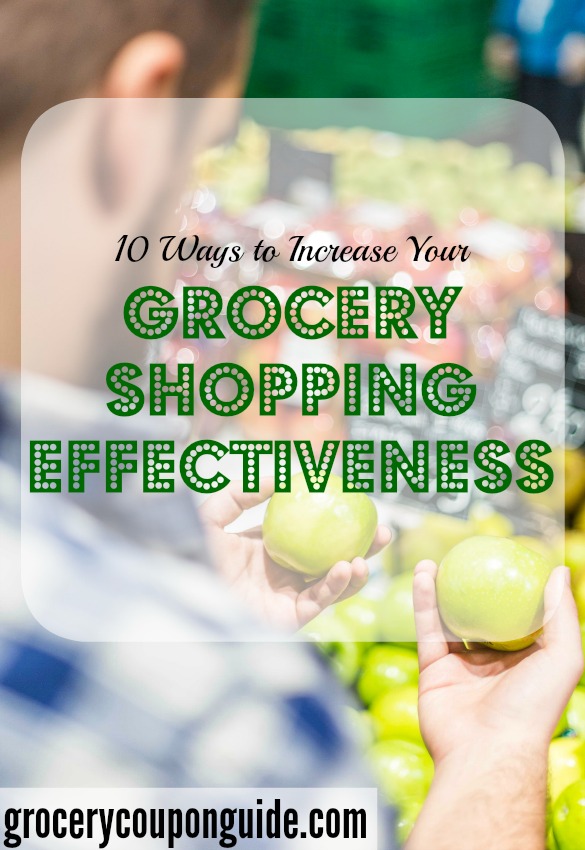Some people absolutely dread grocery shopping. It’s easy to spend a lot of time inside the supermarket, browsing the aisles as you try to remember what you wanted to buy. While many people focus on saving money when thinking about how to reduce their grocery bills, another way to save money is to be better organized and more effective when shopping. The way you shop makes a difference. Here are a few ways that you can increase your grocery shopping effectiveness:

Make a List
One of the best ways to have an effective trip to the grocery store is to make a list of what you plan to buy. Going to the store with a list will help you get in and out in no time. Since you already know what you need, you just need to go to the relevant aisles or display counters, pick up that item, and continue on your way.
Keep Track of What You Already Own
Have you ever gone to the grocery store and stood in an aisle trying to remember if you actually had a bag of sugar at home? Or maybe you want to make pasta but can’t remember if you have enough pasta sauce. In addition to writing a list of what you want to buy, it’s also smart to keep a list of things you already own. You don’t want to waste time trying to remember if you need to buy something you already have, right?
Plan A Menu
While not everyone may be able to plan a week’s menu in advance, it’s a great way to go grocery shopping. Planning a menu means that when you go to the grocery store, you’re only going to buy the items you need for those dishes. Knowing what you’re going to eat for the week will hopefully prevent you from changing your mind and buying other items you don’t need.
Know the Layout of the Store
Knowing the layout of your local grocery store will help you spend less time shopping. If you have a list and know what where it is in the store, you should be able to get in and out in no time at all. There’s nothing worse than going to a store and not knowing where anything else. You end up wasting a lot of time wandering around aimlessly, especially when no one’s around to help you find the items you need. Knowing the layout of the store can prevent that from happening.
Know What’s on Sale
It’s usually a good idea to check the sales flyers before you head to the store. If you’re someone who likes to plan grocery trips around weekly or monthly sales, you’ll end up saving more time browsing the sales flyer at home rather than in the store. Most sales flyers are located in the Sunday newspaper or on the grocery store’s website. Knowing what’s on sale can help you plan your weekly meal and your weekly shopping list.
Don’t Shop Hungry
Have you ever gone to the grocery store on an empty stomach? Suddenly everything looks delicious and by the time you’re home, you realize that you’ve bought a bunch of items you normally wouldn’t even touch. Shopping when you’re hungry tends to not only distract you but convince you to buy anything that looks good. It’s one of the many ways that grocery stores use your senses to encourage you to spend more. If you’re on a set budget or want to keep an orderly pantry, make sure you shop after you’ve eaten.
Set a Budget
Setting a budget is another great way to increase the effectiveness of your trip to the grocery store. If you’re up to date on how much your normal groceries cost and what’s on sale that week, you should be able to figure out how much you can spend. Each person or family will have a different budget amount, but giving yourself a ballpark range will help you limit what unnecessary items you might want to buy.
Cut Back on One-Item Trips
Have you ever run into the grocery store for one item and come out with five instead? If you frequently stop by the store for one item, you should attempt to curb that habit and make one large trip instead of multiple one-item trips each week. Not only can one-item trips potentially cause you to buy more items than you need, but it’s a waste of time. You’re saving much more time and energy by getting everything at once.
Keep Track of Prices
Keeping track of prices while you shop will help prepare you for the final total when you check out. A great way to do this is to write down the prices next to the items on your shopping list. This will help you make sure that all items ring up according to their sale price. After all, you’ve probably had the experience of buying something that was supposed to be on sale only to be charged full price.
Shop During Non-Peak Hours
The best time to go grocery shopping is during non-peak hours. Of course, not everyone has a schedule that will allow them to grocery shop when the store is practically empty. Some of us have to fight through the work or weekend crowds. But if you have the opportunity to shop during off hours, you’ll find yourself saving a lot of time.
(Photo courtesy of chris.corwin)


